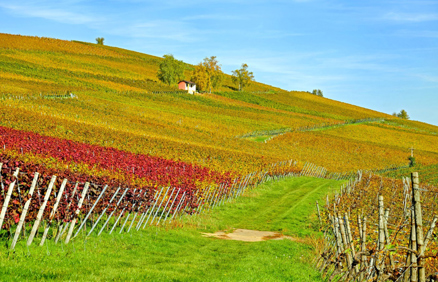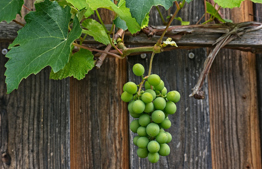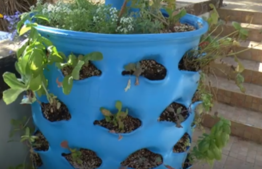“Healthy” wine: a new challenge

Recent years have seen the beginning of a new trend of keeping weeds in vineyards for ecological and other reasons. This article discusses this trend, highlights the major halachic problems it poses vis-à-vis kilei hakerem, and proposes viable halachic-agricultural alternatives.
Foreword
The prohibition of kilei hakerem (intercropping with grapevines) is different from the injunctions against kilei zera’im (interplanting with seeds) and kilei ilan (grafting). Even if one were to plant vegetable seeds together or graft fruits or vegetables in a forbidden manner, the produce is still permitted for consumption. Not so with kilei hakerem: if one interplants in a vineyard, it is prohibited to eat or benefit from the produce grown alongside the vineyard (also called cover crops), and the vine must be also be destroyed, as it states: “פֶּן תִּקְדַּשׁ הַמְלֵאָה הַזֶּרַע אֲשֶׁר תִּזְרָע וּתְבוּאַת הַכָּרֶם” “… else the crop—from the seed you have sown—and the yield of the vineyard may not be used” (Duet. 22:9).
In the past few generations, since the beginning of the Jews’ return to the Land of Israel, and especially now, there are many vineyards for both table grapes and wine grapes growing all over Israel. These vineyards can be found from the tip of the Golan Heights, through the Upper Galilee, and all the way down to the Arava and Mitzpe Ramon in the Negev. Grape harvesting season for table grapes starts in the early spring in the Arava and Jordan Bank, and ends in Shevat for the high quality vineyards in the Lakhish region. Such a long season would never have been possible a decade ago, and certainly not two generations ago. Elongating the harvest season is made possible thanks to smart combinations of different cultivars and to the exploitation of the extremely varied climate conditions all over the Land of Israel, a country not lacking for anything: “אֶרֶץ אֲשֶׁר ... לֹא תְּחַסֵּר כָּל בָּהּ” (Duet 8:7). There is no match anywhere on the globe for such a long harvesting season for table grapes in such a small stretch of land. Of course we must give credit to the amazing farmers who, with their hard work and with Divine assistance, achieve extraordinary results. From a financial perspective table grapes are branded in the marketplace as a high quality crop, so they can be sold expensively throughout the marketing seasons.
The standard practice for growing table grapes includes clearing out all weeds from the vineyards for various reasons, so it is safe to assume that there is little chance of interplanting in table grape vineyards. Until recently, this has also been the standard practice for wine grape cultivation: clearing out any weeds that might compete for water and mineral resources and thereby minimize the risk of pests and the spread of disease.
A. The New Trend in Vineyards
Recent years have seen the beginning of a new trend of leaving weeds in the vineyard; or, alternatively, planting various cover crops alongside them, also known as intercropping or interplanting. Intercropping is not a new method for orchards, but until recently it was rarely used in vineyards. There are several reasons that farmers intercrop:
1. Preventing soil erosion and drift
There are vineyards planted on steep inclines or declines, which are subject to topsoil drift due to rain. Leaving weeds in place or planting annual crops with extensive root systems helps minimize this problem.
2. An agro-ecological ideology that values sustainability, both short-term and long-term
According to this general outlook, any harm done to plants or animals is wasteful and needless. The basis for this thinking, with some limitations, is not new and can be found in Torah sources, as the Midrash states: “See to it that you do not degrade and destroy my world, for if you destroy it no one will be there to fix it up after you” (Midrash Raba, Kohelet 7:1).
3. Minimizing pesticide use
Avoiding spraying the grapes with poisonous chemicals reduces the risk of harming the soil, the greater environment, and the people who consume the produce.
4. Maintaining the beneficial insect population
Leaving weeds or cover crops after blooming and seed dispersal attracts and maintains the beneficial insect population. At the same time, it could provide forage for pests that can destroy the plants or fruit, and then the harm outweighs the benefit. This approach goes together with on ongoing monitoring of the populations of beneficial insects and pests and maintaining a healthy balance between them, as is standard practice in organic farming. At times, farmers pay a heavy price with the diminishing of quality and quantity of the harvest, but generally receive in compensation higher profit for their organic produce. In the case at hand of leaving weeds in the vineyard, the wine is branded “healthy wine.”
There are other reasons for leaving weeds in the vineyard, including:
- Increasing rain penetrability to the soil in heavy rains.
- Reducing soil heat during the summer.
- Reducing water evaporation from the soil while drying the topsoil which, according to some approaches, can enhance wine quality.
- Reducing soil tightening caused by mechanical vehicles driving through the vineyard.
It is not within the scope of this short article to discuss the professional advantages, if such exist, of all of these rationale. I will just cite several facts:
- The grapevine root system is much deeper than that of annual weeds.
- Most grapevines in Israel are irrigated and fertilized by a drip-irrigation system, which means that the vine growers are generally able to easily monitor grape quality.
- Most areas where vineyards are grown receive approximately 350–650m2 of rain annually, so to produce a greater and more qualitative yield that will be profitable, additional irrigation is necessary during the summer months.
- Even vine growers who leave the weeds spray them alongside the grapevines and drip pipes.
B. The Problem of Kilei Hakerem in the New Cultivation Method
The approach of not harming fauna and flora is generally appropriate, but not when it comes to grapevines. The Torah commanded us not to interplant grains and legumes in a vineyard, and even obligated us to uproot any such crops and grapevines when grown together. This is a biblical injunction, “,פֶּן תִּקְדַּשׁ הַמְלֵאָה” which the Gemara explains as “פן תוקד אש” “lest it be liable for burning” (Kiddushin 56b). This situation poses a conflict between the universal value of preserving nature and the Torah injunction against intercropping.
This conflict raises several questions:
- Which types of crops are prohibited due to kilei hakerem?
- From which stage in the growth of cover crops and grapes does the prohibition begin?
- Is it prohibited to cultivate plants that sprout in the vineyard on their own?
- When should one uproot weeds in the vineyard and how should it be done? Is mowing them down sufficient?
- Are there halachically permissible solutions for keeping weeds or cover crops in the vineyard without transgressing the prohibition of kilei hakerem?
1. Which types of crops are prohibited due to kilei hakerem?
It is a biblical prohibition to sow vegetables, grains, or legumes together with grape pips. It is also prohibited to sow these crops alongside a grapevine. When two seeds of a vegetable, grain, or legume are sown together with a grape pip, one is liable for lashes from the Torah. While it is prohibited from the Torah to sow only one seed of vegetable, legume, or grain together with a grape pip, lashes are not mandated.
Today, vineyards are not planted using grape pips; rather, grapevines are first prepared and grown in a nursery. This is where grapevine scions are grafted onto (generally permissible) rootstocks, and only then are they planted in the vineyard. What follows is that in light of the current practice today, lashes would not be mandated (which are not administered today in any case), but the prohibition remains.
With this in mind, we will focus on the scenario where a vine grower plants or allows to grow—that is, does not uproot—vegetables, legumes, or grains in the vineyard. The prohibition of kilei hakerem includes all types of annual vegetables, grains, and legumes and those that are perennial and grow back from the root. Crops customarily planted or grown for human or animal consumption and sprout on their own in a vineyard must be uprooted. Weeds that are not generally sown or cultivated for human or animal consumption and sprouted on their own are not prohibited in a vineyard, and need not be uprooted.
2. From which stage in the growth of cover crops and grapes does the prohibition begin?
Crops sown or planted adjacent to a grapevine are prohibited for consumption and benefit from the time they take root in the soil, and they must be uprooted. For seeds and plants this process takes just a few days when the soil is moist. The determining stage for grapes is when they reach the size of what is termed a pol halavan (white bean) by halacha. When vegetables or other produce take root at the same time when grapes reach the size of a pol halavan, both are prohibited for consumption and benefit, and both need to be uprooted and burned. There are various opinions as to the definition of a pol halavan. According to Prof. Y. Felix, this refers to a lablab bean (Lablab purpureus). Dr. Moshe Raanan maintains that it is a black-eyed pea (Vigna unguiculata). In any case, this refers to the intermediate stage between being completely unripe to the stage when the grape begins to ripen. Sowing crops in a vineyard transgresses the prohibition of kilei hakerem even when the grapevines are exfoliating.
3. Is it prohibited to cultivate plants that sprout in the vineyard on their own?
As noted above, the approach of leaving foliage in the vineyard does not differentiate among the different types of plants that sprout on their own, and even views growing a heterogeneous mixture of cover crops as advantageous. Throughout Israel there are many weeds, legumes, and grains from many different botanical families that sprout after rainfall, develop through the winter, and flower from spring to mid-summer. The most prevalent of them include grains such as wheat, barely, and oats, some self-seeding grains derived from the domesticated grains, and yet others of wild varieties that are relatives of their domesticated cousins. There are also many types of legumes, such as vetch and lathyrus, as well as certain varieties of clover and mustard. The time they grow and the season of flowering varies from year to year and from region to region, depending on the rainfall distribution and temperature at the time of blossoming. In relatively cool years with abundant rain, the growth and blossoming season will extend for longer periods than in hot years with little rainfall.
A simple glance at the roadsides and at fields can give us an idea of the many types of plants that can grow on their own in a vineyard when there is no weed prevention. The most prevalent of these are wheat, barley, oats, and mustard. Since these four species and related families are all customarily planted and cultivated in commercial areas in Israel and abroad, they need to be uprooted if they sprout on their own in the vineyard.
4. Mowing the weeds
There are farmers interested in keeping weeds in their groves for various reasons, some mentioned above (preventing drift, soil hardening, etc.), but do not want weeds to compete with the trees for water and fertilizer in the soil. For this reason they mow the weeds above the soil with various types of machinery (blade system mulcher, chain mulcher, string trimmer, etc.), without disturbing the physiological soil equilibrium. In this way, they retain the advantages of preventing drift, while preventing the weeds from competing for the trees for water and nutrients.
When mowing is done in the winter, most types of grains and legumes grow back and need to be mowed again and again until they wither on their own and no longer grow again. In orchards this is a standard, accepted approach and has many benefits. But in the cases of table or wine vineyards, we must first see if according to the halacha mowing weeds that will grow back again is sufficient to avoid the prohibition of kilei hakerem; or, alternatively, if it is halachically necessary to uproot or spray the weeds to prevent them from growing back. We will leave the final decision in the hands of the poskim.
For weeds to grow back after mowing depends on: (1) the amount of water available in the soil that weeds have at their disposal and (2) the length of the rainy season. The longer the rainy season persists, the greater chance weeds have to grow back. Towards spring, various summer weeds begin to sprout, which are very different from the winter weeds. The summer weeds generally have a deep root system and a greater ability to survive in hot weather. As mentioned above, the vast majority of vineyards are watered in the summer, so all of the weeds in the vineyard can benefit from pleasant growing conditions and a regular water supply. The space between grapevine rows is much smaller than the space between the rows in orchards, so weeds can easily reach the irrigated, moist soil. Not getting rid of the weeds in the vineyard can lengthen the time winter weeds thrive into the summer, including several types of grains.
In Israel today, types of wheat and other grains are grown for aesthetic purposes in commercial areas during the summer. Inbar wheat, for instance, while used for human consumption is grown also for aesthetic purposes during the summer. These wheat cultivars thrive in the summer when they enjoy irrigation and growing conditions appropriate for the hot climate. What follows is that refraining from getting rid of weeds in the grapevine can result in various types of commercial grains growing alongside them, thanks to the irrigation provided to the grapes.
5. Solutions for growing weeds in the vineyard
Up until now we have discusses the problems involved in leaving weeds in vineyards. What can we offer farmers interested in growing cover crops for professional reasons (drift prevention, reducing soil hardening, etc.) while still observing the halachot of kilei hakerem?
There are certain types of annual legumes that are not grown today for human or animal consumption, and they can be sown in fields to receive the same benefit. Sowing one of these legumes without allowing weeds to sprout can be a viable solution for farmers.
Conclusion
- The new trend of leaving weeds in the vineyard is prohibited according to most poskim and doing so poses the halachic risk of producing wine that is prohibited for drinking and benefit.
- This method is possible for orchards, but not for vineyards.
- Farmers interested in growing cover crops in the vineyard, for various reasons, should first consult with a competent halachic authority in the field.




